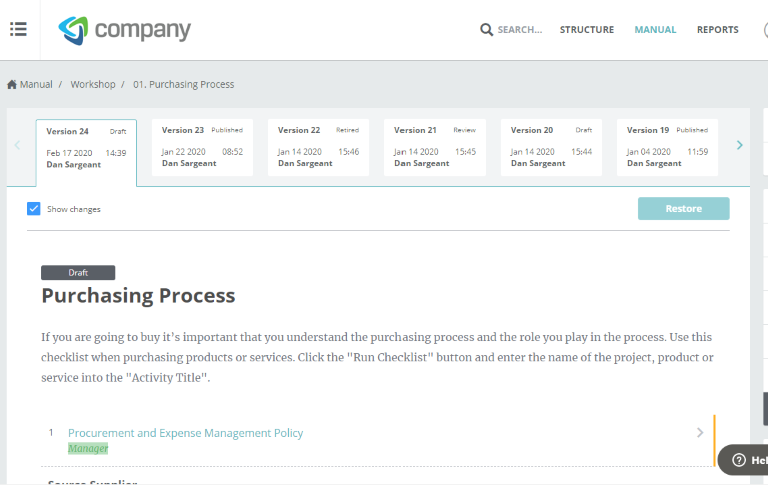Every single edit of a procedure has been saved and stored as a version in the Way We Do platform. Today, we have released a new feature called “Edit History” that allows editors and general users to visually see the changes that have been made from version to another.
This feature has been requested by a number of Way We Do customers, so it was important for us to prioritize this development in 2020.
Benefits of Edit History
There are two main reasons why organizations want Edit History.
Firstly, when employees are re-accepting policies and procedures, they want to see what has changed since the last time they accepted it. Was it just a spelling mistake fixed, or is there new content they need to be aware of? Edit History makes it easy for users to visually see these changes so they know what is relevant to their role, and what they need to adjust in their day-to-day activities.
Secondly, for organizations that have compliance requirements, it was important to them to demonstrate to auditors the changes made to their procedures and processes since the last time they visited. In some industries, it is critical they are able to demonstrate these changes and be transparent in a fully documented audit trail.
Where to access Edit History
Edit History is available as a button on the right-hand side of a policy, procedure or Activated Checklist. It looks like clock, with an arrow indicating turning back the clock.

When clicked, a carousel of edit versions are displayed at the top of the page. Each version has a version number, the procedure status, the date and time the edit was committed to the database when the editor clicked the save button, and the name of the editor.

The latest version appears on the left-most side, and users are able to click back in time to view other revisions available. Previous versions can be restored as a new version by clicking the “Restore” button.
Keeping accessibility in mind for vision-impaired users, any additions to the procedures are displayed in green text and highlighting, and deletions are displayed in red text with a strike through and highlighting. Some formatting changes are displayed in orange, with a dotted line underneath text.
To view the changes, simply click the “Show Changes” option. Changes displayed in a standalone policy or procedure include:
- text additions and deletions
- text format changes (bold, italics and underline)
- image additions and deletions
- video or other rich media additions and deletions.
Displaying changes in an Activated Checklist from one version to the next was more challenging. Revisions displayed in Edit History for an Activated Checklist include:
- step additions and deletions
- step order changes
- step instruction panel content additions, deletions and format changes (bold, italics and underline)
- role changes
- dependencies additions and removals
- removal and addition of Step Mandatory By Default Status
- removal and addition of Comments On By Default.

Changes Not Displayed in Edit History
While Edit History visualizes changes from all edits saved for existing standalone policies and procedures in your Way We Do account, this function does not come into effect for existing Activated Checklists until further edits are made. You will still be able to view each version; however the “show changes” button is disabled for previous edits. Any changes that you make from today onward will enable the “show changes” button.
Some formatting changes are not displayed in the new Edit History feature. These include:
- heading <H> size changes, for example, from <H1> to <H2>, or <H1> to normal text
- indenting and alignment of text (right, center, left, full)
- inserting tables (except where text has been added, changed or deleted upon insertion)
- inserting or changing links or file attachments on existing text (except where text has been added, changed or deleted upon insertion or modification).
Additionally, any criteria that is changed in the right-hand buttons of the procedure are not visually shown in Edit History. This includes roles, tasks, schedules, acceptance, labels, revision dates and restriction. Criteria changes have been seen as separate from the procedure content and are therefore not tracked at this point in time.
Keep in mind, that roles added or removed from individual steps of an Activated Checklist are tracked and visually displayed within Edit History revisions.
Upcoming Version Number Developments
Currently each edit saved to a procedure or Activated Checklist is recorded in Way We Do’s database as a new version number; however we recognize it is really an edit or revision number that is chronicled.
Immediately after releasing the Edit History function, we started developing a more advanced version numbering system and procedure publishing process. The Version Numbering development will follow best practices regarding automatic numbering. Edits will be recognized as incremental version numbers (minors), whereas the approved published version will be displayed as a whole version number (majors).
If you have any questions about Edit History and/or the upcoming Version Numbering development, please reach out to our support team.





